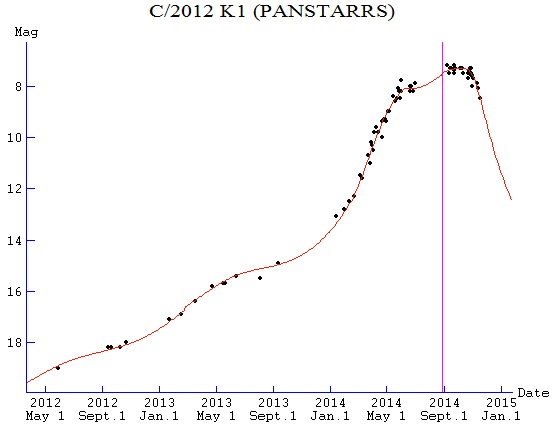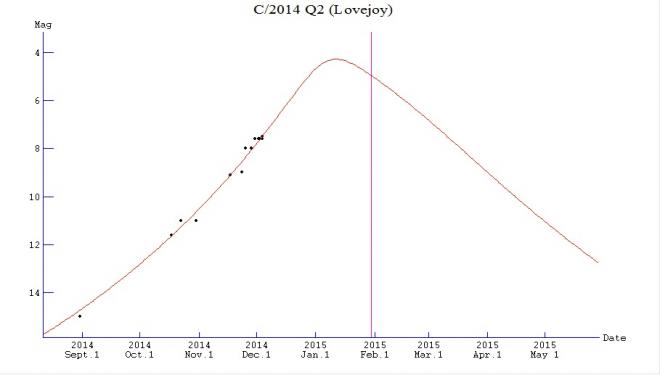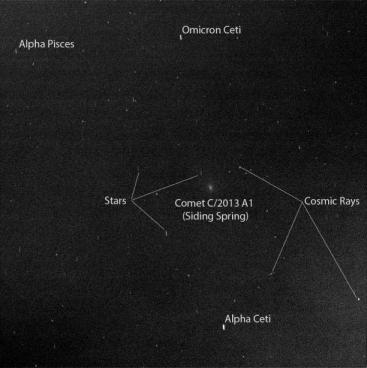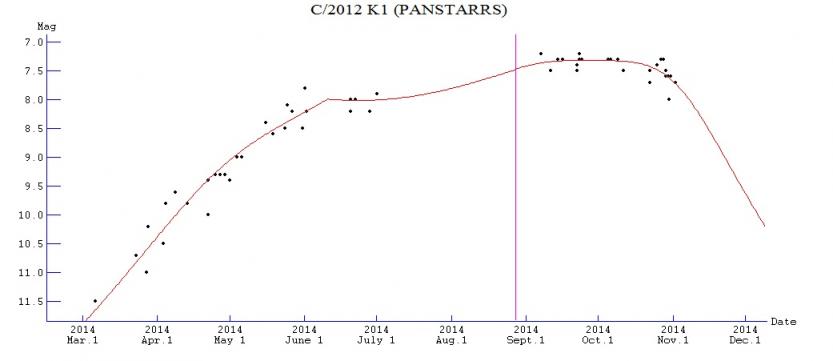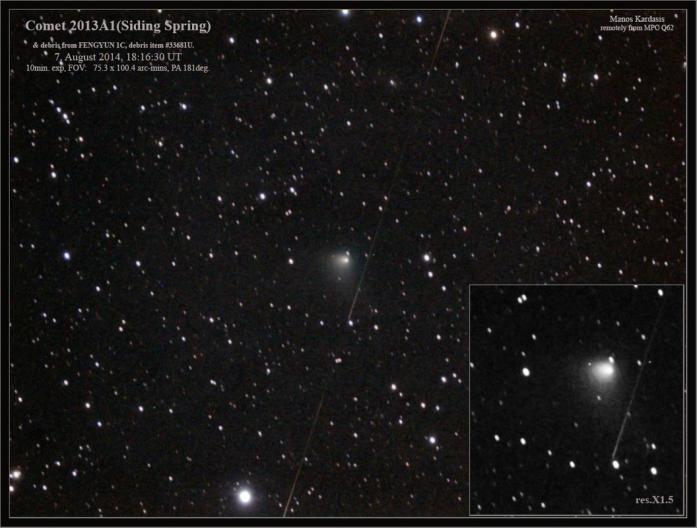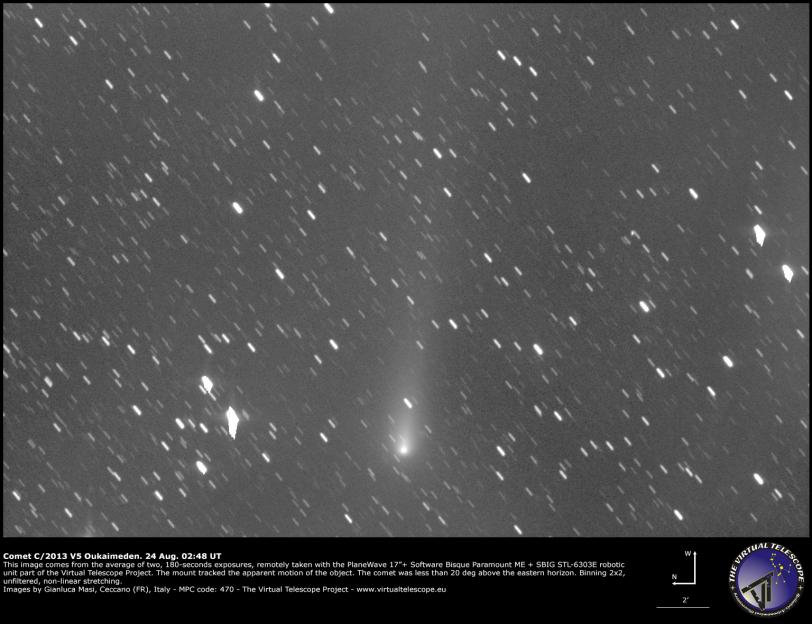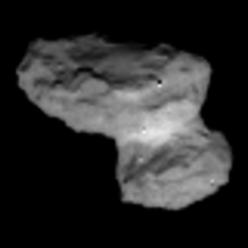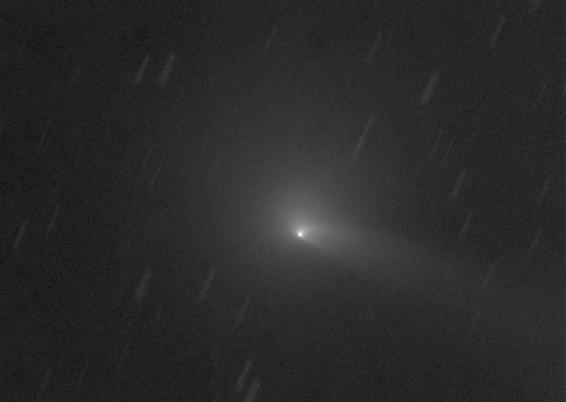ALPO COMET SECTION NEWS FOR DECEMBER 2014
2014-December-9
Latest News
Activity has been slower than usual the past month. Though C/2012 K1 (PANSTARRS) and C/2014 Q2 (Lovejoy) were bright enough for small aperture observers, both were located far to the south and difficult objects from northern mid-latitudes. Luckily Willian Souza of Brazil has been contributing a steady stream of magnitude estimates for both comets. This month, PANSTARRS drifts further north but will also fade past 10th magnitude. Lovejoy on the other hand is on pace to become a nice 5th magnitude comet by the end of the year.
On November 12, the European Space Agency made an historic first as they placed the Philae lander on the surface of short-period comet 67P/Churyumov-Gerasimenko. An article containing more details on Philae, the rest of the Rosetta mission and Comet Siding Spring’s close flyby of Mars can be found in the next issue of the JALPO.
Comet Section members (Salvador Aguirre, Carl Hergenrother, Willian Souza) have contributed visual and CCD magnitude estimates during November for comets C/2012 K1 (PANSTARRS), C/2012 X1 (LINEAR), C/2013 A1 (Siding Spring), C/2013 US10 (PANSTARRS), C/2013 X1 (PANSTARRS), C/2014 E2 (Jacques), C/2014 Q1 (PANSTARRS), C/2014 Q2 (Lovejoy), C/2014 Q3 (Borisov) and C/2014 R1 (Borisov). CCD images for comets 201P/LONEOS, C/2013 A1 (Siding Spring) and C/2014 R1 (Borisov) were submitted by Rik Hill, Manos Kardasis and Gianluca Masi.
Evening Comets
C/2012 K1 (PANSTARRS) [Perihelion on 2014-Aug-27 at 1.05 AU from the Sun]
C/2012 K1 has been with us for a long time now. Comet Section members have been following it for 2.5 years as it brightened from magnitude 18.7 to a peak around 7.2 this September. More than 3 months past perihelion, it has now faded to around 9th magnitude. This month the comet will continue to fade (from 9th to 11th magnitude) as it moves further from the Sun (1.83 to 2.19 AU) and Earth (1.44 to 2.29 AU). Lost to most northern observers for the past month or two, PANSTARRS will once again peak above the southern horizon for northern mid-latitude observers as it moves northward through the constellations of Phoenix (1-17) and Sculptor (17-31).
Recent ALPO images and observations of C/2012 K1 (PANSTARRS) can be found in the Comet Section Image Gallery and Magnitude Database. Finder charts can be found on the Comet Chasing website.
Morning Comets
C/2014 Q2 (Lovejoy) [Perihelion on 2015-Jan-30 at 1.29 AU from the Sun]
When first imaged by Terry Lovejoy of Australia on 2014 August 17, C/2014 Q2 was still a faint 14th magnitude. Always expected to become a nice small telescope/binocular object, it has exceeded expectations by brightening at a rapid clip. Recent reports place the comet around magnitude 7.0 to 7.5. If it continues its current rate of brightening (and that’s always a big ‘if’ with any comet) Lovejoy may be a 5th magnitude object by the end of December. The show will continue into January/February as Lovejoy passes within 1.29 AU of the Sun (on January 30) and 0.47 AU of Earth (January 7/8). This month it can be seen moving northwestward through Puppis (1-16), Columba (16-27) and Lepus (27-31) as it moves closer to the Sun (1.57 to 1.36 AU) and Earth (1.05 to 0.50 AU).
Recent ALPO images and observations of C/2014 Q2 (Lovejoy) can be found in the Comet Section Image Gallery and Magnitude Database. Finder charts can be found on the Comet Chasing website.
New Discoveries
Since the last ALPO Comet Section News posting in early November, an impressive 14 comets were discovered. 10 comets are credited solely to the Pan-STARRS NEO survey [P/2014 U4 (PANSTARRS), P/2014 V1 (PANSTARRS), P/2014 W1 (PANSTARRS), C/2014 W2 (PANSTARRS), C/2014 W3 (PANSTARRS), P/2014 W4 (PANSTARRS), C/2014 W8 (PANSTARRS), C/2014 W9 (PANSTARRS), C/2014 W10 (PANSTARRS) and C/2014 W11 (PANSTARRS) while members of the Catalina Sky Survey and Mount Lemmon Survey (same personnel, different telescopes) found 3 others [C/2014 W6 (Catalina), C/2014 W7 (Christensen) and P/2014 W12 Gibbs]. One comet [C/2014 W5 (Lemmon-PANSTARRS)] is a shared discovery between the two camps. All of these new discoveries were faint (18th-21st magnitude) and should remain faint. C/2014 W2 (PANSTARRS) may become the brightest of the lot at 13th magnitude in early 2016.
As always, the Comet Section is happy to receive all comet observations, whether images, drawings or magnitude estimates.
- Carl Hergenrother (ALPO Comet Section Coordinator)

